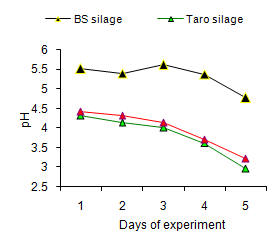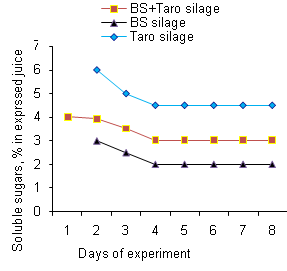|
Back to Content
|
MEKARN Conference 2010
Live
stock production, climate change and resource depletion
|
|
A note on ensiling banana pseudo-stem with Taro (Colocasia esculenta)
leaves and petioles
Dao Thi My Tien, Nguyen Tuyet Giang*
and T R Preston**
An Giang University
dtmtien@agu.edu.vn
**TOSOLY, UTA-Colombia, AA#48,
Socorro, Santander, Colombia
trpreston@mekarn.org
Abstract
An experiment was carried
out to examine the effect of ensiling banana pseudo stem with Taro leaves and
petioles. Chopped samples of each plant were ensiled in plastic bags alone or as
a 50:50 mixture (DM basis) over a period of 7 days. pH values in the Taro and
Taro-pseudo stem silages fell to 4.0 – 4.5 within 24 h and then to 3.0 – 3.5
after 4 days with no differences between the two silages. pH of the ensiled
banana pseudo stem alone was in the range of 5;0 – 5.5 throughout the 7 day
ensiling period. Soluble sugars were highest in the Taro silage and lowest in
the pseudo-stem silage.
It is concluded that
ensiling Taro foliage (leaves + petioles) with banana pseudo-stem markedly
improved the quality of the final product as compared with un-supplemented
pseudo-stem, and that the Taro petioles are a good source of energy because of
the content of NDF and ADF and high content of sugars. The potential nutritive
value for ruminants of the ensiled Taro foliage/banana pseudo-stem combination
should be investigated.
Key words:
ADF, energy, NDF, pH, sugars
|

|

|
|
Figure 1.
Pattern of pH change in ensiled banana pseudo-stem (BS) with and
without incorporation (50:50 DM basis) of Taro foliage (changes in
the pH of Taro silage are also shown) |
Figure 2.
Change of soluble sugars in ensiled banana pseudo-stem (BS) with and
without incorporation (50:50 DM basis) of Taro foliage (changes in
Taro silage are also shown) |

